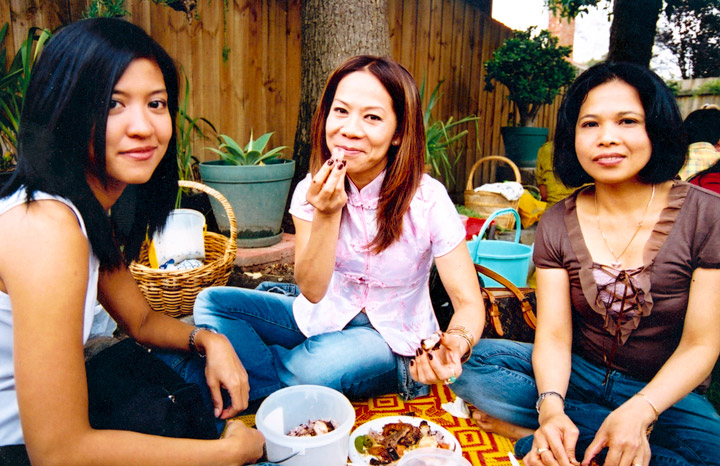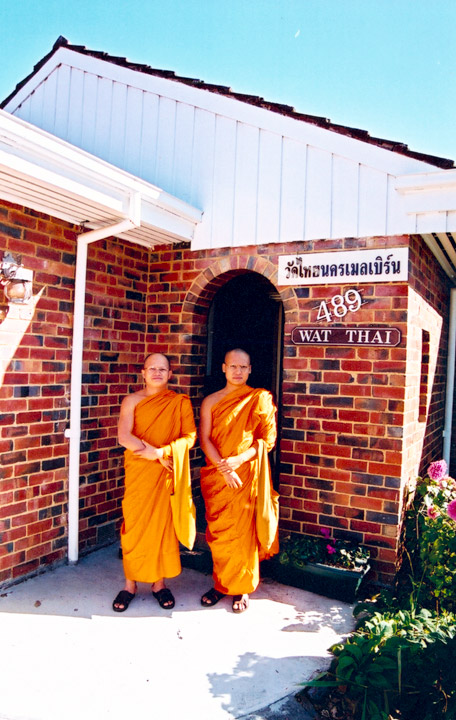Immigration History from Thailand (Thai) to Victoria
ประเทศไทยไม่มีประวัติการอพยพไปอยู่นอกประเทศที่มีลักษณะสำคัญ เมื่อก่อนชุมชนไทยในวิคตอเรียยังคงเล็กอยู่และได้เติบโตขึ้นเมื่อไม่กี่สิบปีมานี้
การสำรวจสำมะโนประชากรของวิคตอเรียเมื่อค.ศ.1901 (พ.ศ. ๒๔๔๔) บันทึกไว้ว่ามีคนมาจากประเทศไทย๓คน นายบุศยมหินทร์เป็นคนไทยที่มีความสามารถคนแรกที่ได้มาเยือนประเทศออสเตรเลียเมื่อต้นคริสต์ทศวรรษ 1920 (พ.ศ. ๒๔๖๓) โดยรัชกาลที่๖ได้ทรงส่งมาเพื่อให้ซื้อม้าแข่ง ความสัมพันธ์กับราชตระกูลไทยได้กระชับแน่นแฟ้นยิ่งขึ้นเมื่อพระเจ้าบรมวงศ์เธอพระองค์เจ้าบุรฉัตรไชยากร(กรมหลวงกำแพงเพชรอัครโยธิน)ได้ทรงนำคณะมาดูงานด้านการเกษตรและพื้นฐานของโครงสร้างของออสเตรเลียในปีค.ศ.1927 (พ.ศ. ๒๔๗๐)
คนไทยเข้ามาประเทศออสเตรเลียเพิ่มอีกเพียงเล็กน้อยและได้มามากขึ้นภายใต้โครงการโคลัมโบในช่วงต้นคริสต์ทศวรรษ1950(พ.ศ.๒๔๙๓) ซึ่งให้นักศึกษาจากประเทศไทยและภูมิภาคเอเชียแปซิฟิคสามารถเข้ามาศึกษาเล่าเรียนในประเทศออสเตรเลียได้ นักศึกษาเหล่านั้นจะได้อาศัยในประเทศเป็นเวลาชั่วคราวเท่านั้น ยกเว้นในบางกรณี เช่น ผู้สมรสกับชาวออสเตรเลียจึงจะได้รับอนุญาตให้อาศัยเป็นการถาวร ช่วงค.ศ. 1966 (พ.ศ.๒๕๐๙) จำนวนประชากรไทยในวิคตอเรียยังคงมีเพียง ๒๔๐ คนเท่านั้น
หลายสิบปีต่อมามีผู้เข้ามาใหม่ที่มาจากประเทศไทยส่วนใหญ่ยังคงเป็นนักศึกษา คู่สมรสของชาวออสเตรเลียและผู้ถูกอุปถัมภ์ให้มาฝึกอบรมทางการทหาร
ระหว่างคริสต์ทศวรรษ 1980 (พ.ศ. ๒๕๒๓) นักศึกษาไทยในประเทศออสเตรเลียเพิ่มขึ้นเป็นจำนวนมาก ทั้งนี้เนื่องมาจากคนไทยที่มีฐานะมั่งคั่งมีมากขึ้น กอร์ปทั้งเกียรติคุณด้านการศึกษาในระดับต่อจากชั้นมัธยมของประเทศออสเตรเลียได้ขจรไกลไปยังนาๆประเทศ ระหว่างค.ศ. 1981 – 1991 (พ.ศ. ๒๕๒๔ - ๒๕๓๔) จำนวนผู้กำเนิดในประเทศไทยที่อาศัยในวิคตอเรียขยายขึ้นถึง๔เท่าโดยเพิ่มจาก ๗๑๘ คนเป็น ๓,๐๓๘ คน
ผู้เข้ามาใหม่ที่มาจากประเทศไทยระหว่างค.ศ. 1996 – 1997 (พ.ศ. ๒๕๓๙ - ๒๕๔๐) ส่วนใหญ่อพยพเข้ามาในประเภทสิทธิพิเศษของครอบครัว ดังนั้นจึงรวมถึงคู่ครองและบุตรของผู้ที่อาศัยในประเทศออสเตรเลียด้วย
ในปี 2011 ชุมชนไทยเกิดใน Victoria ถึง 10,766 คนมีจำนวนมากอยู่ในพื้นที่ท้องถิ่นของเมลเบิร์น, Greater พยาบาลและ Boroondara มีสัดส่วนสูงมีงานในมืออาชีพธุรการขายและบริการบทบาท ไทยเป็นภาษาพูดมากที่สุดที่บ้าน (58%) และพุทธศาสนาส่วนใหญ่ (69%) วัดเบญจมบพิตร (วัด) มีบทบาทสำคัญในสังคมไทยให้ทั้งจิตวิญญาณและศูนย์วัฒนธรรมสำหรับสมาชิก



